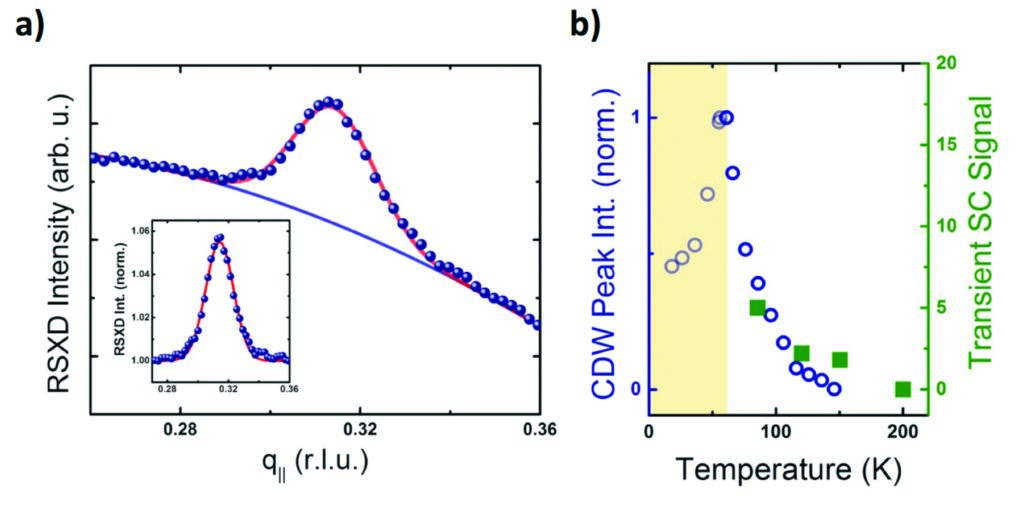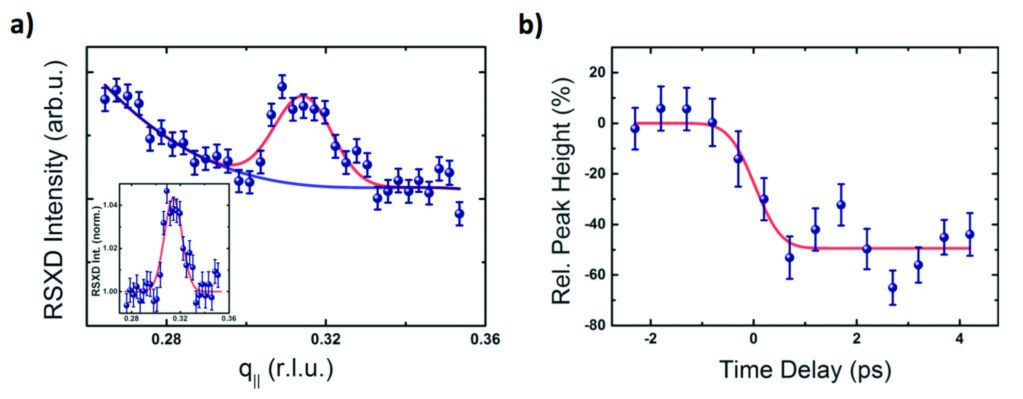 | ||
The fate of charge density wave order while superconductivity is enhanced by light in the high-TC cuprate YBa2Cu3O6.6 |
Beamline I06 Scientific Highlight
A detailed understanding of high-temperature superconductivity in the doped copper oxides is still one of the grand goals in condensed matter physics. As a general feature, as hole dopants are introduced into the Mott insulating parent compound and spin correlations are progressively removed, an unconventional gapped state is formed which then – at low enough temperatures – turns into a superconductor as hole doping approaches ~5%. Notably, the competition between the long-range phase coherence in the superconducting state and charge/spin ordering phenomena in the normal state is believed to be a key ingredient in determining the critical temperature TC, particularly for the underdoped compounds. This interplay has been identified as a general phenomenon in many of the cuprates, including the single-layer La2-x(Ba/Sr)xCuO4 and the bi-layer YBa2Cu3O6+x compounds1,2.
Recently, it was shown that mid-infrared femtosecond pulses, resonantly exciting vibrational modes of the crystal lattice, could be used to affect this interplay in the single-layer compounds at low temperatures. Three- Surfaces and Interfaces Village Beamline I06 dimensional superconducting phase coherence was achieved from a nonsuperconducting state, likely caused by the melting of charge stripe order3. In YBa2Cu3O6+x, optical excitation of apical oxygen distortions causes an even more striking effect, enhancing coherent interlayer transport below TC and inducing a ~ps short-lived state with important similarities to the equilibrium superconductor up to temperatures far above TC. These dynamics were studied by time-resolved THz spectroscopy capable of following low-frequency optical fingerprints of the three-dimensional superconducting state4,5.

Figure 1: (a) RSXD scan of the CDW-related diffraction peak in YBa2Cu3O6.6 at 62 K temperature. These data were taken at Diamond using π-polarised X-rays at the Cu L3 edge (blue data points), with
q|| the in-plane component of the diffraction wave vector along the (1 0 0) direction; (b) temperature dependence of the integrated intensity of this CDW peak (blue circles) and of the strength of the
transient superconducting state, with the latter extracted from the THz probe data presented in Ref. 4.
This work investigated the fate of the in-plane charge density wave (CDW) order in YBa2Cu3O6.6 in this non-equilibrium state. To this end, RSXD on I06 was combined with a time-resolved diffraction experiment at the Linac Coherent Light Source free electron laser. The sample investigated was a detwinned crystal of YBa2Cu3O6.6 synthesised by the self-flux method and exhibiting a critical temperature TC = 62 K.
The bi-axial CDW order was observed through RSXD at the Cu L3-edge (931.5- eV), at the incommensurate q|| ~0.31 in-plane wave vector. Fig. 1a shows a rocking curve of this diffraction peak measured from the cleaved (001)-oriented YBa2Cu3O6.6 sample at TC ~ 62 K lattice temperature. The temperature dependent intensity of the CDW peak is depicted in Fig. 1b. Starting at about 160 K, the CDW state is progressively stabilised with decreasing temperature before becoming suppressed again as superconductivity emerges below TC. Next to the integrated scattering intensity from the equilibrium CDW, this figure also plots the temperature dependent strength of the light-induced coherent state, represented by the optically transformed volume fraction4. Evidently, the static CDW and the light induced superconducting coherence track each other very closely, underscoring a possible correlation between the two phenomena.

Figure 2: Crystal structure of orthorhombic YBa2Cu3O6.6 and the motion of the apical oxygen
atoms (red shadows) associated with the resonantly excited c-axis B1u phonon mode.
This RSXD experiment was performed in the time domain following optical excitation using 400 fs-long pulses at 15 μm wavelength, made resonant with the B1u-symmetry infrared-active apical oxygen distortion (670 cm−1) shown in Fig. 2. An excitation fluence of 4 mJ/cm2 was chosen to resemble the excitation conditions used in the THz probe experiments. The photon energy of the free electron laser was tuned to the 931.5 eV Cu L3-edge, with a bandwidth of 0.5 eV set by a grating monochromator. On this resonance, the X-ray pulses were absorbed in 200 nm depth, far less than the sample volume determined by 2 μm extinction depth of the mid-infrared pump light.

Figure 3: (a) The same RSXD scan of the CDW peak as shown in Fig. 1a, now measured at the Linac Coherent Light Source free electron laser. Although the noise level has clearly increased, the diffraction peak was detected at the same position in reciprocal space and with about the same amplitude above the fluorescence background (see inset); (b) transient height of this diffraction peak induced by direct excitation of the apical oxygen mode using 400 fs pulses at 15 μm wavelength, polarised along the c axis.
The observed disappearance of charge order occurs on a time scale comparable with the appearance of superconductivity4, emphasising the correlation between the two phenomena. However, while the transient plasma edge survives only for 5–7 ps, the charge order remains melted for a significantly longer time.
Source publication:
Foerst, M., Frano, A., Kaiser, S., Mankowsky, R., Hunt, C. R., Turner, J. J., Dakovski, G. L., Minitti, M. P., Robinson, J., Loew, T., Le Tacon, M., Keimer, B., Hill, J. P., Cavalleri, A. & Dhesi, S. S. Femtosecond x rays link melting of charge-density wave correlations and light-enhanced coherent transport in YBa2Cu3O6.6. Physical Review B 90, doi:10.1103/PhysRevB.90.184514 (2014).
References:
1. Tranquada, J. M., Sternlieb, B. J., Axe, J. D., Nakamura, Y. & Uchida, S. Evidence for stripe correlations of spins and holes in copper-oxide superconductors. Nature 375, 561-563, doi:10.1038/375561a0 (1995).
2. Ghiringhelli, G. et al. Long-range incommensurate charge fluctuations in (Y,Nd)Ba2Cu3O6+x. Science 337, 821-825, doi:10.1126/science.1223532 (2012).
3. Foerst, M. et al. Melting of Charge Stripes in Vibrationally Driven La1.875Ba0.125CuO4: Assessing the Respective Roles of Electronic and Lattice Order in Frustrated Superconductors. Physical Review Letters 112, doi:10.1103/PhysRevLett.112.157002 (2014).
4. Kaiser, S. et al. Optically induced coherent transport far above Tc in underdoped YBa2Cu3O6+δ. Physical Review B 89, doi:10.1103/PhysRevB.89.184516 (2014).
5. Hu, W. et al. Optically enhanced coherent transport in YBa2Cu3O6.5 by ultrafast redistribution of interlayer coupling. Nature Materials 13, 705-711, doi:10.1038/nmat3963 (2014).
Funding acknowledgements:
The research leading to these results has received funding from the European Research Council under the European Union’s Seventh Framework Programme (FP7/2007-2013) / ERC Grant Agreement no. 319286 (Q-MAC).
Corresponding author:
Dr Michael Foerst, Max Planck Institute for the Structure and Dynamics of Matter, [email protected]


 A brighter light for science
A brighter light for science
